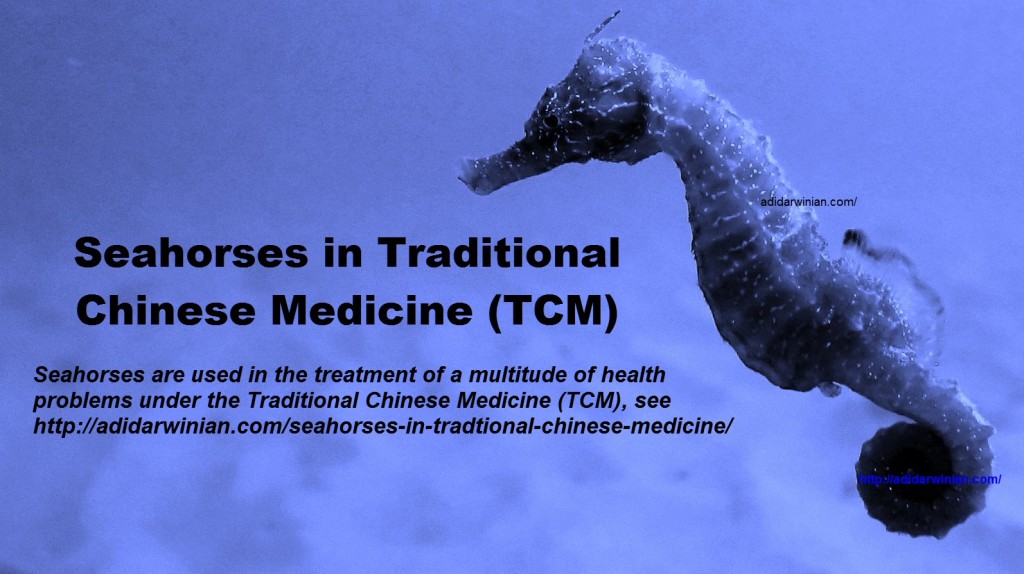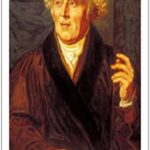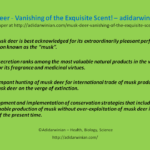Seahorses are magnificent fishes that exhibit the phenomenon of male pregnancy. Pregnancy in males is unique to seahorses in the entire animal kingdom, thus, making them a true biological marvel. This exclusive behavior was discussed in detail in my research article titled “Seahorse – Male Endurance – Roles Swapped!!” Here, in this new research paper / article, I shall explore the use of seahorses in Traditional Chinese Medicine (TCM).
Seahorses are globally exploited for use as aquarium fishes, curios (articles or objects of curiosity), medicines, and even foods. Use of Seahorses in Traditional Chinese Medicine (TCM) was first mentioned in the book named “Bencao Shiyi” (Supplement to Materia Medica), written by Chen Cangqi around 720 A.D.
Seahorses are used in the treatment of a wide range of health problems under the Traditional Chinese Medicine (TCM), which is a complementary and alternative system of medicine (CAM). You can refer to my article – “The Basis of Traditional Chinese Medicine (TCM)” to learn the fundamentals of TCM. Seahorses are employed in the treatment of sexual weakness, reduced sexual desire or drive (reduced libido; libido means sexual desire or sex drive), and are considered as broad-spectrum or general tonics. The practitioners of TCM claim that seahorses strengthen “kidneys” and improve “nerves”, which in the context of Traditional Chinese Medicine points to general morale, well-being, and vigor. “kidneys” also imply sexual function in the context of TCM. Seahorses are categorized under sweet, salty, and warm medicines. They are usually not prescribed alone but in combo-preparations (formulations containing multiple ingredients) containing matter from other animals and plants.
Species of Seahorses in Traditional Chinese Medicine (TCM)
Following species of seahorses are commonly employed in the Traditional Chinese Medicine (TCM):
• Hippocampus histrix (Thorn Seahorse or Chi Hai Ma)
• H. japonicas (Small Seahorse or Xiao Hai Ma)
• H. kelloggi (Wrinkled Seahorse or Xian Wen Hai Ma)
• H. kuda (Large Seahorse or Da Hai Ma)
• H. trimaculatus (Three-spotted Seahorse or San Ban Hai Ma)
• H. coronatus (Crowned Seahorse or Guan Hai Ma)
 Diseases Treated by the Use of Seahorses in Traditional Chinese Medicine (TCM)
Diseases Treated by the Use of Seahorses in Traditional Chinese Medicine (TCM)
Seahorses in Traditional Chinese Medicine are used to treat various types of human diseases. The diseases in which seahorses are usually employed for the treatment under Traditional Chinese Medicine (TCM) are as follows, viz. –
• General Enervation (a state of weakness characterized by deprivation of force, strength, energy, vigor, or vitality), Lassitude, Fatigue, Pain, etc.
• Disorders of Throat such as inflammations, infections, abscess, swelling of lymph nodes, and accumulation of phlegm.
• Diseases of Respiration, especially, Asthma
• Diseases of Thyroid Gland
• Diseases of Sexual Organs such as impotence, premature ejaculation, decreased potency, unsuccessful and painful erections, and reduced libido (diminished sexual desire). Impotence, also known as Erectile Dysfunction (ED), is the inability of a male to engage in the act of sexual intercourse because of the failure to get or maintain a sufficient level of erection Seahorses are considered as “aphrodisiac”, which in the common medical parlance means possessing the property of enhancing sexual desire. In the Traditional Chinese Medicine (TCM), the original word for “aphrodisiac” is “Zhuang Yang”. Zhuang Yang has a much broader meaning in the TCM, and is defined as the process of stimulating or invigorating yang by the administration of medicinal substances to promote the vital function of virility in an impotent man. In the ancient Chinese philosophy, “Yang” is the active, positive, masculine principle or quality or force that is complementary and opposing to yin. “Yin” is the passive, negative, feminine principle or quality or force. It appears that in the Traditional Chinese Medicine, seahorses are more commonly employed to improve and strengthen sexual function than to enhance sexual drive (libido).
• Injuries resulting from falls, strains, contusions (see, what is contusion?), and fractures.
• Diseases of Heart and Circulatory System such as heart disease, high cholesterol levels, circulatory problems, and arteriosclerosis. Arteriosclerosis, also known as Arterial Sclerosis, is characterized by thickening, hardening, and loss of elasticity of the arterial walls. Seahorses in Traditional Chinese Medicine (TCM) are also employed as cardiac stimulant.
• Seahorses are used in Dystocia (delayed or slow or difficult labor / childbirth). As seahorse promotes labor, their use is contraindicated during pregnancy.
• Diseases of Liver
• Diseases of Kidney
• Weak Immune System
• Incontinence – Incontinence means inability of a person to control his or her evacuative or excretory functions (urination or defecation) resulting in involuntary passage of urine or feces. The inability to control urination is called Urinary Incontinence. The inability to control defecation is called Fecal Incontinence.
• Diseases of Skin such as subcutaneous ulcers, furuncles (boils), and carbuncles (see, what is a carbuncle?).
• Open Wounds and Cuts
• Mental Diseases
According to the TCM practitioners, a seahorse-based tonic strengthens yang. Traditional Chinese Medicine practitioners tailor TCM prescriptions according to the individual needs of the patients (customized or tailor-made prescriptions).






